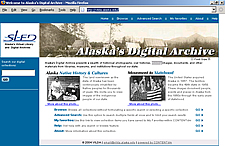Rural teachers tap into digital archive
November 2004
By Kerynn Fisher, University of Alaska Museum of the North
 "Awaken the artist and find the scholar" is Rebecca Greeley’s motto to describe her
teaching style.
"Awaken the artist and find the scholar" is Rebecca Greeley’s motto to describe her
teaching style.
"Whether it is a reading or a typing class, I try to incorporate art into my lessons whenever I can," says Greeley, a 7th and 8th grade teacher at Fort Greely Middle School in Delta Junction. "I think it gives the students alternate perspectives on the world and enhances their understanding of different concepts."
Greeley, who is also working on a master's degree in education at the University of Alaska Fairbanks, is using Alaska's Digital Archive through the University of Alaska Museum of the North to do just that for her students. Funded through a congressional award from the U.S. Department of Education and launched over the summer, the archive brings together more than 8,500 maps, oral histories, photographs, film and other historical documents from libraries and museums in Alaska into one online database, available to anyone via the Internet. The digital archive also includes video and animation, as well as images of paintings and sculptures, Alaska Native clothing, tools and artwork from the University of Alaska Museum of the North.
For her first classroom assignment using the archive, Greeley is having her students answer the question "What's so cool about Alaska?" in multimedia computer presentations. The students must use images or video from the digital archive to illustrate their projects.
 "I'm using this exercise both to introduce the students to the archive and to give
them practice using the Internet for research and developing public presentations,"
says Greeley. "I don't think they'll have any shortage of subjects or images to work
with. There's such a wide range of material available in the archive, it'll be a great
tool for the students to use."
"I'm using this exercise both to introduce the students to the archive and to give
them practice using the Internet for research and developing public presentations,"
says Greeley. "I don't think they'll have any shortage of subjects or images to work
with. There's such a wide range of material available in the archive, it'll be a great
tool for the students to use."
Over the coming months, Greeley will develop additional classroom lessons using the digital archive as part of a pilot program organized by the University of Alaska Museum of the North with funding from the U.S. Department of Commerce's Technology Opportunities Program and the Institute of Museum and Library Services.
![[QUOTE: The digital archive gives us the perfect infrastructure to make our collections more accessible to teachers.]](/news/archives/news-archives-2002-2010/featured/04/vilda/images/callout2.gif) "For years, we've been working to use the Internet to make our collections more accessible
to teachers both in Fairbanks and in rural Alaska," says museum Education Coordinator
Terry Dickey. "The digital archive gives us the perfect infrastructure to do it. Now,
we want to see how the teachers put it to use."
"For years, we've been working to use the Internet to make our collections more accessible
to teachers both in Fairbanks and in rural Alaska," says museum Education Coordinator
Terry Dickey. "The digital archive gives us the perfect infrastructure to do it. Now,
we want to see how the teachers put it to use."
Along with Greeley, 15 other teachers from Alaska's Delta-Greely and Yukon-Koyukuk school districts are working with the museum this school year to develop educational tours and classroom lessons using the digital archive.
 "It's been wonderful to see the variety of projects the teachers are developing using
the archive," says museum Teacher Liaison Robin Davis. "Using modern art to study
Alaska's history since statehood, archival photographs to explore cultural identity
in Old Minto, looking at ways people adapt to Alaska's environment, botany lessons--you
name it, and the teachers are finding a way to use the digital archive to enhance
their specific curriculum needs."
"It's been wonderful to see the variety of projects the teachers are developing using
the archive," says museum Teacher Liaison Robin Davis. "Using modern art to study
Alaska's history since statehood, archival photographs to explore cultural identity
in Old Minto, looking at ways people adapt to Alaska's environment, botany lessons--you
name it, and the teachers are finding a way to use the digital archive to enhance
their specific curriculum needs."
Davis has been involved in the museum's online education efforts since 1999. As a second grade teacher at Fairbanks' Denali Elementary School, she was part of the teacher advisory team working with the museum to develop Northern Journeys, an online curriculum using objects from the museum's archaeology, ethnology and fine arts collections. The museum developed two "journeys"--Dogs in Alaska and Sea Migrations--to teach elementary school students about geography, math, history, culture and science.
 "Northern Journeys is a great resource for elementary school teachers for specific
lessons," says Davis. "One thing we discovered about the journeys, however, was that
they are so focused on specific subject areas they're not as adaptable to the individual
teachers' needs. Now, with the digital archives, we can focus on making a wider range
of material available to complement lessons the teachers develop on any number of
subject areas."
"Northern Journeys is a great resource for elementary school teachers for specific
lessons," says Davis. "One thing we discovered about the journeys, however, was that
they are so focused on specific subject areas they're not as adaptable to the individual
teachers' needs. Now, with the digital archives, we can focus on making a wider range
of material available to complement lessons the teachers develop on any number of
subject areas."
That material includes a growing collection of videos of Alaska's communities, wildlife and artists at work, many of them produced in partnership with rural museums, schools and cultural centers like the Pratt Museum in Homer, the Sheldon Jackson Museum in Sitka and the Tanadgusix Native Corp. on St. Paul Island.
"It's a great urban-rural partnership, and the video footage is the perfect complement to our collections," says Dickey. "Having video that shows how a basket is made and hearing the artist talk about the process of creating art adds a new dimension to the student's understanding and appreciation."
Alaska's Digital Archive - Contributing Institutions
- Alaska State Library, Historical Collections
- Anchorage Museum of History and Art, Archives
- Seward Community Library Association
- University of Alaska Anchorage Consortium Library
- University of Alaska Fairbanks Rasmuson Library
- University of Alaska Museum of the North
For more information, please contact:
- Kerynn Fisher, Communications Coordinator, University of Alaska Museum of the North, (907) 474-6941, klfisher@alaska.edu
- Alaska's Digital Archive, ak-digital-archives@alaska.edu
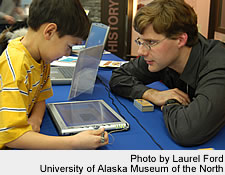
Zedric Placeres explores the museum's multimedia resources on a tablet computer as
Roger Topp looks on.
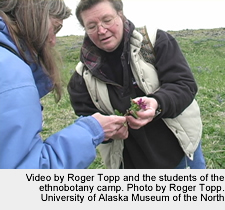
MP4 Movie (9.5MB):
Plant collecting - This video segment from the digital archive shows high school and college students
working with science teacher Betty Taylor and botanist Suzi Golodof to collect native
plants of St. Paul Island for use in classrooms throughout the year.
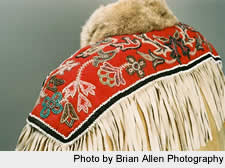
Alaska's Digital Archive includes objects from the University of Alaska Museum of
the North's collections such as this Athabascan chief's jacket (Museum catalog number
0479-0001).
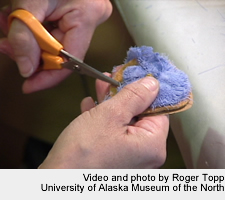
MP4 Movie (4.6MB):
Caribou Tufting - A video of Koyukon Athabascan artist Selina Alexander demonstrating caribou tufting
at the University of Alaska Museum of the North.



